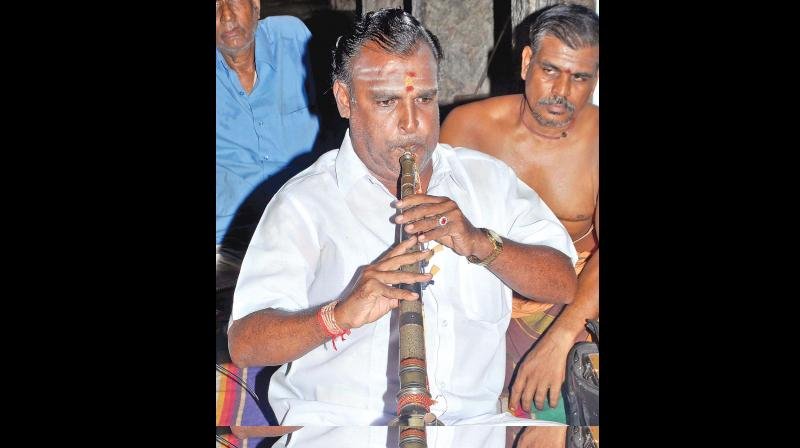Ethereal Ragas In Stone- Granite Nadaswaram Of Kumbeshwarar Temple At Kumbakonam


In Tamil Nadu and in Andhra Pradesh, there are some ancient temples which have stone pillars that produce music. But Tamil Nadu is the rare exception where we can find stone Nadaswaram produced by ancient artisans.
There are three ancient temples in Tamil Nadu whose stone pillars can produce music viz the Thanumalayan temple at Suchindaram in Kanyakumari district, the Nellaiappar temple in Tirunelveli and the Polinthunindrapiran temple in Alwarthirunagari.
Ancient artisans of Tamil Nadu were so gifted that they essentially made wind instrument in stone, the Nadaswarams, to play the ethereal classical ragas of Carnatic music. The traditional music instrument is generally made of wood, but here it is made of a single piece of granite.
The Nadaswaram plays a vital role in all the rituals of temples starting from the morning ‘The Thirupalli Ezhuchi’, a ritual to wake up the presiding Bhagwan to the ‘Palliarai Puja’, a ritual to let the Bhagwan go to sleep in the night.
There are two stone Nadaswarams in Tamil Nadu one each in the Adikumbeshwarar temple in Kumabokonam and the Alwarthirunagari temple.
The Hindu reported on 18.12.2020, that historian Kudavasal Balasubramanian stated that, “We do not have details about when the instruments were made”.
Reportedly, the stone instrument is similar to that of ‘timri’ or the shorter version of the Nadaswsaram, that was in use before Thiruvavaduthurai TN Rajarathinam Pillai designed the “paari” version of the Nadaswaram.
Swaminathan the Nadaswaram player at the Kumbeshwarar temple in Kumbakonam temple stated that, “The uzhau- the middle pipe of the instrument is made of stone. The front portion known as the “anusu” or the volume enhancer and the end portion where the reed is fit while playing are made of brass”.
Notably, unlike other Nadaswarams, the stone Nadaswaram has only six holes. Mr Swaminathan says, “When we handle this instrument, we consciously choose particular scales and ragas conducive to its structure and body”.He added, “For instance, we take time in the lower octaves and often choose ragas with the ‘prati madhymam’, or the sharper variant of the note ‘ma’, like in Kalyani, Shanmugapriya and Panthuvaralai.” Swaminathan also said that one has to put in maximum effort to play the granite Nadaswarams.
It is pertinent to note that the instrument was last played in 2017 after a long gap of 15 years for Saraswati Puja during Navratri. The granite Nadaswaram was earlier played regularly at the Mahamaham and Masi Maham. The granite Nadaswaram was kept in the custody of the HR&CE department managing the temples, so it was not played only in 2017 after 2002, during Navaratri.
The sheer glimpse of achievements of our ancestors in ancient India can only be dreamt about even today with all the modern gadgets and facilities. So, it makes one wonder, whether we have progressed or regressed scientifically and culturally in India in the name of adopting global modernity.
News Source: The Hindu dated, 19.12.2020,
Further reads: Granite Nadaswaram played after 15 years at Kumbakonam | Trichy News – Times of India (indiatimes.com)
DISCLAIMER: The author is solely responsible for the views expressed in this article. The author carries the responsibility for citing and/or licensing of images utilized within the text.
